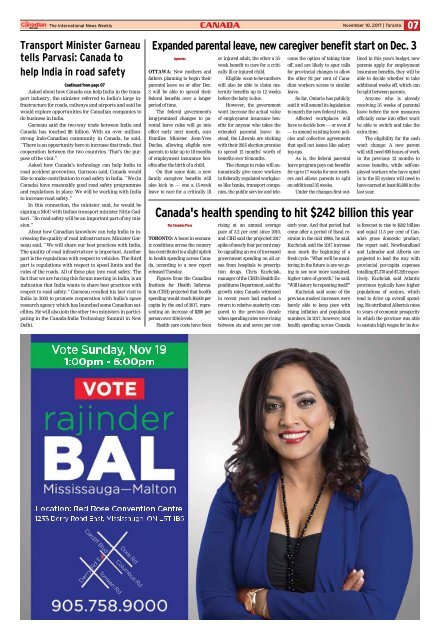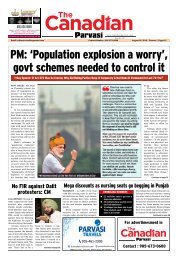You also want an ePaper? Increase the reach of your titles
YUMPU automatically turns print PDFs into web optimized ePapers that Google loves.
<strong>The</strong> International News Weekly CANADA<br />
November 10, <strong>20</strong>17 | Toronto<br />
07<br />
Transport Minister Garneau<br />
tells <strong>Parvasi</strong>: Canada to<br />
help India in road safety<br />
Continued from page 07<br />
Asked about how Canada can help India in the transport<br />
industry, the minister referred to India’s large infrastructure<br />
for roads, railways and airports and said he<br />
would explore opportunities for <strong>Canadian</strong> companies to<br />
do business in India.<br />
Garneau said the two-way trade between India and<br />
Canada has touched $8 billion. With an over millionstrong<br />
Indo-<strong>Canadian</strong> community in Canada, he said,<br />
``<strong>The</strong>re is an opportunity here to increase that trade, that<br />
cooperation between the two countries. That’s the purpose<br />
of the visit.’’<br />
Asked how Canada’s technology can help India in<br />
road accident prevention, Garneau said, Canada would<br />
like to make contribution to road safety in India. ``We (in<br />
Canada) have reasonably good road safety programmes<br />
and regulations in place. We will be working with India<br />
to increase road safety.’’<br />
In this connection, the minister said, he would be<br />
signing a MoU with Indian transport minister Nitin Gadkari.<br />
``So road safety will be an important part of my mission.’’<br />
About how <strong>Canadian</strong> knowhow can help India in increasing<br />
the quality of road infrastructure, Minister Garneau<br />
said, ``We will share our best practices with India.<br />
<strong>The</strong> quality of road infrastructure is important. Another<br />
part is the regulations with respect to vehicles. <strong>The</strong> third<br />
part is regulations with respect to speed limits and the<br />
rules of the roads. All of these play into road safety. <strong>The</strong><br />
fact that we are having this forum meeting in India, is an<br />
indication that India wants to share best practices with<br />
respect to road safety.’’ Garneau recalled his last visit to<br />
India in <strong>20</strong>03 to promote cooperation with India’s space<br />
research agency which has launched some <strong>Canadian</strong> satellites.<br />
He will also join the other two ministers in participating<br />
in the Canada-India Technology Summit in New<br />
Delhi.<br />
Expanded parental leave, new caregiver benefit start on Dec. 3<br />
Agencies<br />
OTTAWA: New mothers and<br />
fathers planning to begin their<br />
parental leave on or after Dec.<br />
3 will be able to spread their<br />
federal benefits over a longer<br />
period of time.<br />
<strong>The</strong> federal government's<br />
long-promised changes to parental<br />
leave rules will go into<br />
effect early next month, says<br />
Families Minister Jean-Yves<br />
Duclos, allowing eligible new<br />
parents to take up to 18 months<br />
of employment insurance benefits<br />
after the birth of a child.<br />
On that same date, a new<br />
family caregiver benefits will<br />
also kick in — one a 15-week<br />
leave to care for a critically ill<br />
<strong>The</strong> <strong>Canadian</strong> Press<br />
TORONTO: A boost in economic<br />
conditions across the country<br />
has contributed to a slight uptick<br />
in health spending across Canada,<br />
according to a new report<br />
released Tuesday.<br />
Figures from the <strong>Canadian</strong><br />
Institute for Health Information<br />
(CIHI) projected that health<br />
spending would reach $6,604 per<br />
capita by the end of <strong>20</strong>17, representing<br />
an increase of $<strong>20</strong>0 per<br />
person over <strong>20</strong>16 levels.<br />
Health care costs have been<br />
rising at an annual average<br />
pace of 3.2 per cent since <strong>20</strong>10,<br />
and CIHI said the projected <strong>20</strong>17<br />
spike of nearly four per cent may<br />
be signalling an era of increased<br />
government spending on all areas<br />
from hospitals to prescription<br />
drugs. Chris Kuchciak,<br />
manager of the CIHI's Health Expenditures<br />
Department, said the<br />
growth rates Canada witnessed<br />
in recent years had marked a<br />
return to relative austerity compared<br />
to the previous decade<br />
when spending rates were rising<br />
between six and seven per cent<br />
each year. And that period had<br />
come after a period of fiscal restraint<br />
in the mid 1990s, he said.<br />
Kuchciak said the <strong>20</strong>17 increase<br />
may mark the beginning of a<br />
fresh cycle. "What we'll be monitoring<br />
in the future is are we going<br />
to see now more sustained,<br />
higher rates of growth," he said.<br />
"Will history be repeating itself?"<br />
Kuchciak said some of the<br />
previous modest increases were<br />
barely able to keep pace with<br />
rising inflation and population<br />
numbers. In <strong>20</strong>17, however, total<br />
health spending across Canada<br />
or injured adult, the other a 35-<br />
week benefit to care for a critically<br />
ill or injured child.<br />
Eligible soon-to-be-mothers<br />
will also be able to claim maternity<br />
benefits up to 12 weeks<br />
before the baby is due.<br />
However, the government<br />
won't increase the actual value<br />
of employment insurance benefits<br />
for anyone who takes the<br />
extended parental leave: instead,<br />
the Liberals are sticking<br />
with their <strong>20</strong>15 election promise<br />
to spread 12 months' worth of<br />
benefits over 18 months.<br />
<strong>The</strong> change in rules will automatically<br />
give more workers<br />
in federally regulated workplaces<br />
like banks, transport companies,<br />
the public service and telecoms<br />
the option of taking time<br />
off, and are likely to spur calls<br />
for provincial changes to allow<br />
the other 92 per cent of <strong>Canadian</strong><br />
workers access to similar<br />
leave.<br />
So far, Ontario has publicly<br />
said it will amend its legislation<br />
to match the new federal rules.<br />
Affected workplaces will<br />
have to decide how — or even if<br />
— to amend existing leave policies<br />
and collective agreements<br />
that spell out issues like salary<br />
top-ups.<br />
As is, the federal parental<br />
leave program pays out benefits<br />
for up to 17 weeks for new mothers<br />
and allows parents to split<br />
an additional 35 weeks.<br />
Under the changes first outlined<br />
in this year's budget, new<br />
parents apply for employment<br />
insurance benefits, they will be<br />
able to decide whether to take<br />
additional weeks off, which can<br />
be split between parents.<br />
Anyone who is already<br />
receiving 35 weeks of parental<br />
leave before the new measures<br />
officially come into effect won't<br />
be able to switch and take the<br />
extra time.<br />
<strong>The</strong> eligibility for the cash<br />
won't change: A new parent<br />
will still need 600 hours of work<br />
in the previous 12 months to<br />
access benefits, while self-employed<br />
workers who have opted<br />
in to the EI system will need to<br />
have earned at least $6,888 in the<br />
last year.<br />
Canada's health spending to hit $242 billion this year<br />
is forecast to rise to $242 billion<br />
and equal 11.5 per cent of Canada's<br />
gross domestic product,<br />
the report said. Newfoundland<br />
and Labrador and Alberta are<br />
projected to lead the way with<br />
provincial per-capita expenses<br />
totalling $7,378 and $7,329 respectively.<br />
Kuchciak said Atlantic<br />
provinces typically have higher<br />
populations of seniors, which<br />
tend to drive up overall spending.<br />
He attributed Alberta's rates<br />
to years of economic prosperity<br />
in which the province was able<br />
to sustain high wages for its doc-

















